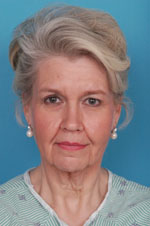Key to aesthetic surgery: patient
education
by
Heather WoolwinePublic Relations
Some people love the idea of plastic surgery and others can’t stand it. But regardless of which side you take or whether you sit comfortably on the fence, everyone can agree that if a patient desires plastic surgery, he or she has the right to be thoroughly educated about the benefits and risks of any cosmetic procedure.
Seung-Jun O, M.D., MUSC Plastic Surgery assistant professor, believes the key to aesthetic surgery is patient education. “Patients have the right and it is important to make sure that they are well-informed,” he said. “Making sure that patients have realistic expectations of what a procedure will do for them is an essential component to this. Facelifts are a good example.”

 Dr. O's patient,
left, prior to facelift. The same patient six weeks post-op.
Dr. O's patient,
left, prior to facelift. The same patient six weeks post-op.In fact, Dr. O explained, the term facelift is a bit of a misnomer, as most people actually refer to a procedure done on the lower half of the face and neck area when determining that a facelift is the perfect fix.
The face is divided into three zones: the upper (brows and above); the middle (from below the eyes to just above the mouth); and the lower (from the mouth down into the neck).
“Finding out and narrowing down what area it is that a patient is really unhappy with is a priority for me, and I find that oftentimes patients are actually unaware of the issue that is really causing them so much unhappiness,” Dr. O said. “With aesthetic surgery on the face, you’re not going to just change one area when you operate. The whole face will change from one simple procedure. However, patients still want to look like themselves.”
While “lunchtime” procedures like Botox and injectibles are becoming increasingly popular in the world of aesthetic procedures, Dr. O pointed out their limitations. “They are not permanent and improvements are subtle when it comes to altering your appearance,” he said.
While everyone is familiar with some of the more bizarre and severe cases of facelifts and other aesthetic surgeries pervasive throughout pop culture, normal, routine procedures like the ones that Dr. O performs are much more predictable and assuring.
“All of the incisions in a facelift are placed in natural skin creases or hair lines. A good surgeon will leave a patient’s face looking refreshed, not pinned back,” he said. “Women who come to see me want to look the way they feel, and that certainly doesn’t mean looking like someone else. Other types of plastic surgery are not that front and center, but working on the face demands that surgeons and patients be on the same page and that the work be well done.”
Although everyone heals differently, patients who undergo a facelift can expect a recovery time in the neighborhood of six weeks, with most swelling and bruising no longer visible around day 10.
Patients who want a facelift need to be in good physical health for the four-hour surgical procedure.
During an initial consultation, patients converse with Dr. O to pinpoint their true desires and then using a mirror, he shows the patient what the procedure will look like. Imaging software in Dr. O’s James Island office is a great advantage to patients, showing approximately what a procedure will do to change the face. “It’s a very powerful way to communi-cate; as the saying goes, a picture is worth a 1,000 words,” Dr. O said.
The end of the consultation focuses heavily on patient education, with topics of discussion including potential benefits, potential risks, what the procedure itself will entail, and realistic expectations for recovery time and results.
Dr. O practices with MUSC’s John Robinson, M.D., and Pat O’Neil, M.D., on James Island offering facial plastic surgery; breast augmentation and lift; body contouring, like liposuction; and skin care and injectable services.
For more information or to schedule a consultation, call 266-6001.
Friday, Nov. 4, 2005
Catalyst Online is published weekly,
updated
as needed and improved from time to time by the MUSC Office of Public
Relations
for the faculty, employees and students of the Medical University of
South
Carolina. Catalyst Online editor, Kim Draughn, can be reached at
792-4107
or by email, catalyst@musc.edu. Editorial copy can be submitted to
Catalyst
Online and to The Catalyst in print by fax, 792-6723, or by email to
petersnd@musc.edu
or catalyst@musc.edu. To place an ad in The Catalyst hardcopy, call
Community
Press at 849-1778.